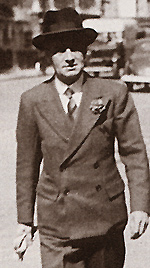|
SHORTLY AFTER the outbreak of the First World War
the then First Lord of the Admiralty, Winston
Churchill, appointed Sir Alfred Ewing, the Navy's
Director of Education, to lead the naval code
breakers' section then located in Room 40 of the
old Admiralty buildings. Ewing not only set up
radio listening stations around the country but
also recruited several language experts from the
Dartmouth and Osborne naval colleges. One of the
first of these naval instructors turned code
breaker was a Scot, Alastair Denniston, who later
became the first head of Bletchley Park.

ALASTAIR DENNISTON
(left) in London during the war.
DENNISTON'S OFFICE
(below-right) at Bletchley was situated on the
ground
floor of the mansion
and under the large copper dome that
has turned green
following exposure to the elements.
Hut 4 can be seen on
the left in the background.
The most fruitful source of code
breakers, however, was the universities. Ewing
selected Dilly Knox and Frank Birch from his old
college, King’s, in Cambridge. Others
included the lawyer, William 'Nobby' Clarke, and
publisher, Nigel de Grey. (De Grey’s effort
provided for Room 40 its greatest First World War
coup, the deciphering of the Zimmerman Telegram.)
During the First World War, there
had been great rivalry between Room 40 and MI1b
with little or no collaboration on code breaking,
merely on the results. At end of the war Room 40
and MI1B were amalgamated into one as the
Government Code and Cypher School (GC&CS)
which was run by Alastair Denniston under Admiral
Hugh Sinclair who at the time was Director of
Naval Intelligence and later (1923 until his
death on 4 November 1939) head of MI6. Its
published duty was to advise the government on
the codes and cyphers it should use. However its
main purpose was covertly to decode the secret
messages being sent into and out of other
countries, both friends and foes.
During the 1920s, a coding machine
named ‘Enigma’ was being marketed by
Arthur Scherbius (born in Germany in 1878 and
later became a Berlin electrical engineer ) who
had invented it in 1918. Originally marketed to
the German industrial and banking sectors to
prevent their professional secrets being
compromised in the normal public telegraph
system, the machine was not a commercial success.
The internal set-up of the machine was
complicated to the degree that it was considered
impossible for an outsider to unravel the coded
messages that it produced. And yet its operation
was so simple that virtually anyone was capable
or putting messages into code.
|